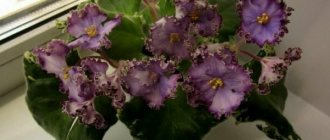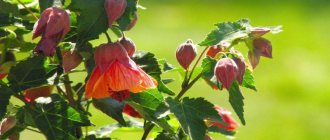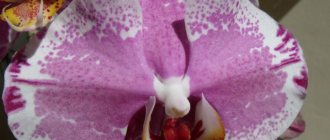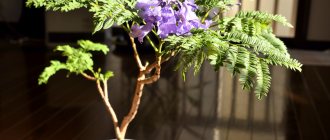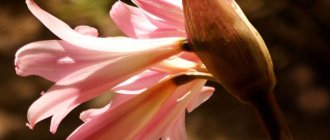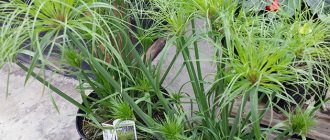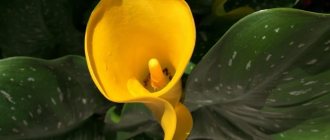Maintenance and care of hipperastrum: how to plant a flower correctly
The flower is propagated mainly by bulbs and children.
During seed propagation, varietal characteristics are not completely transmitted to the offspring. Seedlings bloom in the 3rd–4th year. To obtain seeds, flowers are pollinated artificially. When grown in earthen mixtures, in the summer they are kept in a sunny window or on a balcony, watered and fed abundantly. In August, after the end of growth, watering is gradually reduced, at the end of September dead leaves are cut off, watering is stopped completely and only occasionally (about once a month) water is poured into the pan to prevent the roots from dying off, but the soil in pots with resting bulbs should be touchable dry, not wet. Pots with resting bulbs are kept in a dry and dark place at a temperature of about +7–10 °C. Lower temperatures are harmful to indoor hippeastrums even during the dormant period. In December-February, pots with bulbs are placed in a warm place with a temperature of +20–25 °C (for example, near a stove or central heating radiator) and not watered at all until the flower shoot appears, after which the pots are transferred to a bright window and poured into a tray warm water so that the dried soil is well saturated with it. If the water has cooled down and the top layer of soil in the pot is still dry, replace the cooled water with warm water several times. Until the flower arrow reaches 7–9 cm in height, water very moderately, since otherwise the leaves will grow and the flowers will not develop. Then watering is gradually increased.
30–40 days after flowering, hippeastrums are transplanted into a nutrient mixture composed of leaf, humus and turf soil with an admixture of washed coarse sand (1: 2: 1: 1). With proper cultivation and care, hippeastrums are replanted every 2–3 years. Annual replanting is not necessary, but it is necessary to change the top layer of soil every year. When transplanting, remove the bulbs from the pot, shake off all the old soil from the roots and cut off the rotten roots with a sharp knife. The bulb should sit in the ground no deeper than 2/3 of its height. Transplanted indoor hippeastrums are kept on a bright window in a warm room and watered with warm water. Pots should not be too spacious. It is enough if the distance between the wall and the bulb is 2–3 cm. In a very spacious container, the plant may not bloom for a long time.
A faster way to vegetatively propagate hippeastrum flowers at home is by dividing the bulbs. From one mature bulb you can get up to 40 children. The onion is cut so that each part has a piece of the bottom and scales, the sections are sprinkled with crushed charcoal and the onion slices are placed in boxes with a light peat mixture. After 40–50 days, children are formed, which are planted in pots next spring.
Many gardeners advise planting and caring for hippeastrum in hydroponic culture. It is grown in double flowerpots on a nutrient substrate of expanded clay with sand in a 2:1 ratio using LTA-2 solution. Hydroponic cultivation is not difficult at all. In the autumn-winter period, when the leaves have died, the plant is kept somewhere in a semi-dark place at +7–8 °C in a solution of very low concentration (25–45%), periodically moistening the expanded clay around the inner pot, where some of the roots are also preserved. Since January, flowerpots with bulbs are exposed to light and with the appearance of a flower arrow, the concentration of the nutrient solution is increased to 100%. At this time, it needs good lighting and a temperature of +20–22 °C. After the flower shoot develops, the leaves begin to grow. Strong specimens of hippeastrum at home produce two inflorescences with three huge flowers. Intense, green, erect leaves catch up with the flower arrow in growth. By autumn, the plant gradually enters a dormant period, the leaves die off. After flowering, the children are separated from the mother bulb. Keeping and caring for hippeastrum is possible not only as a potted plant, but also in a winter garden.
How does the crossing process occur?
It is unlikely that all the hippeastrums in the house will bloom at the same time. Therefore, it is necessary to provide for the possibility of storing pollen. Plastic ziplock bags and a place in the refrigerator door work well for this. Of course, fresh pollen germinates much better, but after 3 weeks of storage it also germinated for me.
It all starts with "dad". From the moment the hippeastrum flower opens, it is advisable to start observing it and catch the beginning of pollen maturation. Immature pollen lies in a thick layer on the stamens, and mature pollen begins to crumble when touched. This happens on the 2nd - 3rd day after the flower opens. At this moment, you need to pluck out the anthers, say, with tweezers, carefully put them in a bag and sign: the date and what variety it was taken from. Place the bag in the refrigerator.
Next, observations of the potential mother plant begin. After the flower opens, it is advisable to “castrate” it, that is, pluck out the anthers before the pollen ripens, in order to know for sure that the flower has not been pollinated by its own pollen. This pollen can also pollinate something.
Some time after the pollen ripens (which would have happened if the anthers had not been plucked out), the pistil will open and be ready for pollination. This is clearly visible visually: its three doors, previously closed, open and release a drop of nectar. So it's time. As a rule, this happens in the morning. The best temperature for pollination is +18…+22°C. At higher temperatures and dry air, pollen quickly loses moisture and the process goes much worse.
You need to take the pollen out of the refrigerator and put it in a warm place - let it warm up for an hour. Then carefully open the bag and “dip” the pestle into the spilled pollen. You can use a cotton swab, or you can simply pick up the stamen with the pollen that has not fallen off and “roll” it over the pistil - this option is especially good if the parent plants bloom at the same time and the stamens are freshly cut.
Now be sure to hang a tag on the flower - the name of the father’s plant, the mother’s plant, the date of pollination and the freshness of the pollen (the date indicated on the pollen bag).
There is no need to be complacent about this, because a flower that is pollinated twice has a greater chance of setting seeds. This means that it would be good to repeat the procedure with the remaining pollen the next morning.
For the purity of the experiment, it would be a good idea to tie the pollinated flower with gauze so that no accidentally awakened fly would interfere with the selection process. But it is not necessary, especially since gauze definitely does not add beauty to the blooming hippeastrum.
Then you just have to wait, one and a half to two months or even two and a half. It depends on the temperature, the general condition of the plant and the specific variety. The ripening capsules of hippeastrum are three-chambered. As soon as they begin to crack, the seeds are ready and you can proceed to sowing. Check freshly collected seeds by immersing them in water; throw away those that float. There is no need to waste energy and time on something that does not sink.
Reproduction of hippeastrum
Reproduction of hippeastrum by children
Hippeastrums reproduce by seeds, by dividing the bulb and by children. It is easier to implement the vegetative method, which preserves all the characteristics of the parent hippeastrum in the new plant. When replanting, well-formed hippeastrum children with developed roots that have reached a diameter of 2 cm are separated from the mother bulb and, after treating the fracture sites with crushed coal, they are planted in separate pots to a depth of 2 cm. For two years, do not cut leaves from young plants even during the dormant period . The daughter bulbs of hippeastrum bloom in the third or fourth year.
Hippeastrum propagation by dividing the bulb
Some varieties of hippeastrum do not produce children, so they are propagated by dividing the bulb. Using a sharp sterile knife, cut the onion into several parts so that each has a part of the bottom with roots. The sections are treated with wood ash or crushed coal, dried for several days, after which the sections are laid out in separate pots with perlite or a mixture of sand and peat so that parts of the bottom with the roots simply lie on the substrate.
You can not cut a large onion into pieces completely, but simply make several deep cuts on it at the same distance from each other, without cutting the bottom. The wounds are treated with charcoal, the bulb is dried for two to three days and placed in a pot on a substrate consisting of perlite or a mixture of peat and sand. Water the bulb through a tray, and after a while, babies form at its base. You already know how to separate and plant them.
Hippeastrum from seeds
Hippeastrum is also propagated by seed, but the disadvantage of generative propagation is that it does not preserve the varietal properties of the parent plant in the offspring, so it makes sense to grow only species-specific hippeastrum from seeds.
Hippeastrum seeds should be sown immediately after they ripen, when they have almost one hundred percent germination. They are embedded in the soil to a depth of 1 cm, watered, covered with film and the crops are placed in a warm place. The seedlings will appear in 2-3 weeks, and as soon as this happens, you will need to immediately remove the covering and place the seedlings in the brightest place under bright but diffused light. Grown seedlings are planted in separate cups and, as they grow and develop, they are fed with a weak solution of mineral fertilizer for deciduous plants. Young plants do not need a rest period.
Varieties of hippeastrum
Thanks to breeding work, there are 90 species and 600 hybrids of the plant. The most popular include:
- Royal. The variety has high decorative properties. A plant up to 30-50 cm in height forms inflorescences with petals pointed towards the edge, resembling a large star. Flowers painted in bright scarlet color leave no one indifferent.
- Alfresco. This unusual plant attracts attention with soft cream flowers and a greenish core, up to 15 cm in diameter, decorating a peduncle up to 45 cm in height. The inflorescences are slightly drooping, voluminous, the petals are arranged in 3-4 layers. Green foliage forms after flowering. Bulbs up to 7 cm in diameter form 2-3 peduncles.
- White. Hippeastrum is valued for its snow-white flowers, up to 17 cm in diameter. The length of the peduncle is up to 55 cm. It is capable of forming up to 4 buds. The bulb is large, capable of forming 2 peduncles at the same time.
- Striped. The flower grows more than 1 m. It got its name because of the petals decorated with red-lilac stripes.
- Hybrid. The plant captivates the eye with its red-orange buds; you can also see a mix of white and green shades in the color of the inflorescences.
- Red. The flower is characterized by a large bulb, green leaves, and red inflorescences. The petals are oblong with slightly pointed ends.
- Mix. The plants are distinguished by oblong leaves of intense green color, strong peduncles, 35-50 cm in height, producing 2-3 flowers, bulbs 8-10 cm in diameter.
Each variety amazes with its spectacular flowering, beautiful color and high decorative qualities.
Benefits and harms for humans
It is worth remembering that the juice of the bulbs is poisonous, so all manipulations are carried out with gloves. Do not allow juice to come into contact with mucous membranes and skin. When working without gloves, upon completion, you should immediately wash your hands with soap.
Amazing properties are attributed to hippeastrum. It is believed that this flower is conducive to fantasy, so it is simply necessary for writers. The plant is also beneficial in kindergartens, supporting the creative thinking of children. Naturally, they put it in places inaccessible to children. It is not recommended to place hippeastrum at work, unless it is associated with creativity.
How to properly water and fertilize a flower
When the plant is just growing green mass, you should not water it abundantly; soil moisture should increase by the time the hippeastrum blooms. At this time, it is important to moisturize abundantly, but without excess.
For the procedure, settled and not cold water is taken. When watering, you need to make sure that it does not fall on the bulbous part. When the hippeastrum fades, you should gradually reduce watering, and then reduce it to nothing.
From time to time you need to wipe the leaves of the plant with a damp cloth. When the peduncle reaches a significant height, which is about 15 cm, you need to water the soil with a solution of potassium permanganate. And after five days, add phosphorus-based fertilizer to the soil.
In general, it is necessary to fertilize the crop during the growing season every 15 days. To do this, purchase a product for deciduous plants in the store. When the leaves hatch, it is necessary to add fertilizer for flowering crops.
Diseases and pests of garden and indoor flowers
Even if the plant is not planted in open ground for the summer, it can get sick or acquire pests even in indoor conditions. Most often, hippeastrums are susceptible to diseases such as red burn fungus, downy mildew and red rot. The disease can be determined by the appearance of the flower:
- the leaves and bulb are covered with red spots - a fungal burn;
- a white coating appeared on the leaves - powdery mildew;
- withered leaves and the formation of putrefactive discharge on the bulb is rot.
Red burn of hippeastrum
Rot is removed as follows:
- carefully examine the flower and the underground part, remove the affected areas;
- leave the bulb alone for several hours, allowing it to dry;
- prepare new soil:
- Before planting, the bulb is treated with a solution of Fundazol.
Special preparations that can be purchased at flower shops will help you get rid of powdery mildew. To get rid of the red burn, dig up the bulb and trim off all affected areas. The cut areas are treated with a mixture of copper sulfate and chalk (1:20). The bulb is left in this form for a week, after which it is planted in new soil. It is advisable to treat the soil with a suitable fungicide before planting.
The most common pests of indoor hippeastrum are scale insects, spider mites, aphids and scale insects. You can get rid of them using special insecticides.
Diseases and insects can be the main reason why hippeastrum does not bloom. It is necessary to promptly detect pests and diseases that can harm this beautiful plant.
It will also be interesting: Vallota - care at home and types of indoor plants?
Seed propagation
The propagation method from seeds is longer and more labor-intensive. In addition, it will not be possible to preserve the variety, since many types of hippeastrum are hybrids. But there are also advantages to this type of propagation - there is a chance to get several seedlings at a time if the seeds take root successfully.
The sequence of propagation by seeds is as follows:
- Using a brush, pollen is transferred from the stamen of one flower of a crop to the stigma of another. For successful pollination, the process is performed twice. It is better to carry it out on clear sunny days.
- If fertilization is successful, then by the end of flowering the mother plant will have small fruits in the form of capsules with seeds. If the room is warm (up to 22 degrees), then the pod will ripen within 2 months. As soon as you can see that the container for the seeds has dried out and started to crack, you can start collecting them.
- The seeds will need to be sown in a prepared substrate. To do this, take a mixture of turf soil and leaf soil, coarse sand and humus, their ratio should be as follows: 1: 2: 2: 1. The soil needs to be moderately moistened.
- In order for the seeds to germinate successfully, they need to be provided with an air temperature of up to 25 degrees.
- When the seedlings produce a couple of leaves, they can be planted in larger pots.
Caring for hippeastrum at home
How to care for hippeastrum
The indoor hippeastrum flower needs good lighting, so it is preferable to keep it on southern, southwestern and southeastern windowsills, provided that direct sunlight does not fall on the plant during the midday hours. In order for the flower to remain compact and slender, it needs to be rotated around its axis from time to time. In the warm season, hippeastrum is comfortable at a temperature of 17-25 ºC, but it will be even better if you place it in the garden, on a terrace or balcony, while protecting it from drafts and too bright sun.
Growing hippeastrum involves regular application of fertilizers to the substrate. They feed homemade hippeastrum twice a month from the beginning of the period of active growth with a solution of mineral fertilizers for deciduous plants, and when the flower has leaves, they switch to fertilizers for flowering indoor plants, watering the soil in the pot with them in the same mode. The concentration of the solution should not be too strong, otherwise you may burn the roots of the plant. When the hippeastrum flower shoot reaches 12-15 cm, water it with a pale pink solution of potassium permanganate, and after a few days add phosphorus fertilizer to the soil.
Watering hippeastrum
At the beginning of the growing season, after the hippeastrum leaves the dormant period, watering is carried out very moderately, even meagerly, but gradually the water consumption and frequency of watering are increased: the hippeastrum in the pot should not feel thirsty, especially during the period of formation of the peduncle and the appearance of buds. As soon as the flower arrow reaches a height of 7-8 cm, the substrate must be kept slightly moist at all times: blooming hippeastrum really needs moisture. To prevent water from getting on the bulb, it is better to moisten the soil using the method of bottom watering: settled water at room temperature is poured into a tray under the pot until the entire earthen lump of the hippeastrum is wet. When the dormant period begins, watering is gradually reduced until it stops completely.
Hippeastrum transplantation
There is no need to torment indoor hippeastrum with annual transplants. It is enough to transfer it from a pot that has become cramped to a new one, 2-3 cm larger in diameter, once every 3-4 years. Hippeastrum is planted in a new pot after flowering or after a dormant period. The container for the plant is chosen to be narrow and high: between the bulb and the walls of the pot there should be a layer of earth no more than 2 cm thick. Hippeastrum needs soil with approximately the following composition: one part each of humus, sand and peat and two parts of turf soil. Or: one part humus, and two parts each of leaf soil, perlite (coarse sand) and turf soil. Be sure to place a thick layer of drainage material at the bottom of the vessel. After transshipment of the hippeastrum and filling the space in the pot with soil mixture, the plant bulb should look out from the substrate by at least a third of its body. If you do not intend to replant the plant in any season, change the top layer of substrate 5 cm thick in the pot.
Hippeastrum after flowering
In order for a plant to bloom every year, it must rest fully. The dormant period of hippeastrum usually lasts from the end of summer to the end of October. After the leaves have completely dried out, during which watering is gradually reduced and fertilizing of the plant is stopped completely, you need to remove the wilted leaves, cut off the stem, transfer the hippeastrum to a dark, dry room with a temperature no higher than 10-12 ºC, put the pot with the bulb on its side and leave without watering for 6-8 weeks. After this period, the flower is returned to its usual place, they begin to water it little by little and resume feeding.
Some hobbyists grow hippeastrum without allowing it to rest. They keep it in a warm room all year round, water it and fertilize it. However, neither a person nor a plant can do without rest and sleep for a long time, so be prepared for the fact that one day, despite all your worries, the hippeastrum will stop blooming.
Hippeastrum - what kind of flower is it?
Hippeastrum is a representative of the flora of South America of the Amaryllidaceae family. The plant's homeland is tropical America.
The bulbous perennial has:
- round or conical root system, reaching 8-10 cm in diameter;
- a conical bulb, consisting of a short thick stem and closed scales, measuring from 5 to 10 cm in diameter;
- linear leaves of green color, 50-70 cm in length, 4-5 cm in width, which are placed in 2 opposite rows;
- umbrella-shaped inflorescences containing 2-6 bisexual flowers, 13-15 cm long, up to 25 cm in diameter, which are formed on a leafless peduncle up to 40-80 cm in height;
- funnel-shaped or tubular flowers located on elongated petioles, painted in all shades of red, orange, white;
- a fruit with small black seeds, presented in the form of a tricuspid capsule, spherical in shape, which remain viable for a long time.
Information! The life cycle of the plant is 10-12 years.
Caring for hippeastrum at home
Proper care of home hippeastrum includes the creation of certain conditions: temperature, light level, room humidity. These indicators may vary depending on the phase of flower development. The decorative beauty of each plant will depend on proper care.
Lighting
The light-loving plant will feel comfortable on the southeast, south or southwest side of the house. In the wild, the flower grows in the steppes, so it is not afraid of direct sunlight. It can be placed both under direct rays and in a room with diffused light. On very hot days, it is advisable to shade the flower from the excessively scorching sun. Hybrid bulbs that shed their leaves during the dormant period can be placed in a cool, dark place.
Temperature
Low temperatures (below 5 ˚С) have a bad effect on the formation of peduncles. During the dormant period, the bulb is able to survive a short-term drop in temperature to -1 °C.
Sudden temperature changes have a bad effect on flower development.
Optimal temperature for the plant:
- during daylight hours – 20-22 ˚С;
- in the dark - not less than 18 ˚С.
The maximum permissible humidity level in the environment is 80%. High humidity can cause disease and even death of the plant. You should not spray the leaves; it is better to sometimes wipe them from dust with a damp cloth.
How to water and feed correctly
Proper watering for a flower is very important, because at different times it needs a certain amount of moisture. At the first signs of hibernation, watering is completely excluded. You can add a little water to the pan for vital processes in the bulb. After waking up, they begin to water moderately and quite rarely - once every two weeks.
During the formation of the peduncle, water the flower regularly, while adhering to the following recommendations:
- water for irrigation should be at room temperature;
- the soil should not be excessively wet;
- The soil should dry out between waterings;
- Do not let liquid get on the bulb.
In the wild, hippeastrum blooms only during the rainy season, and during drought the bulbs rest. Therefore, the frequency of watering should imitate natural conditions.
The plant needs high-quality and timely feeding. Fertilize should be done once every ten days. During the dormant period, the flower is not fed. The composition of fertilizers depends on the stage of flower development:
- The beginning of growth requires nitrogen-potassium fertilizers.
- For the full formation of a peduncle, fertilizing is applied, which contains potassium, nitrogen and phosphorus.
- During the flowering phase, they are fed with phosphorus-potassium complexes.
The first fertilizing is applied after the flower shoot reaches a height of 10-15 cm.
Soil and pot
To make it easier for the flower to absorb nutrients, the filler in the pot should be light and loose and have excellent moisture and water permeability. Experienced flower growers advise preparing a substrate from the following components: peat, deciduous soil and river sand. You can purchase ready-made filler at a flower shop. Begonia soil will be an excellent soil for a flower.
Sometimes ash or compost is added to the soil.
To grow this variety, you should purchase a narrow and tall flowerpot. This is due to the rather long roots of the plant, which feed the bulb even in the dormant phase. Choose a pot that is not too spacious: the distance between the pot and the bulbs should not exceed 2 cm.
Preparation for winter and rest period
The dormant period lasts from September to January. If the flower was planted in open ground for the summer season, then with the arrival of autumn it should be moved to the apartment. Watering the flower is gradually reduced, the leaves begin to dry out. After the leaves and stems are completely dry, the stem is removed and the bulb is placed in a dark place.
The flowerpot is moved on its side and left at a temperature of 10-12˚C for 6-8 weeks.
The flower can do without the dormant stage. To do this, it must be under bright light throughout the year, in a warm room, and regularly receive fertilizer and watering. With this mode, the flower can bloom in mid-autumn or mid-spring. Rich green foliage remains attractive all year round.
It will also be interesting: Amaryllis - flower care at home, planting and growing?
Growing hippeastrum
The basic requirements of a plant when growing include choosing the right location, sufficient illumination, nutritional composition of the soil, optimal temperature conditions for the crop and humidity level.
Priming
The culture is not demanding on the soil. Any loose soil for bulbous flowers will do. Peat, humus, and sand or vermiculite can be added to garden soil.
Important! Hippeastrum does not tolerate stagnation of water. Therefore, at the bottom of the pot you need to pour a drainage layer of stones and clay shards.
Temperature
The temperature in the room should be moderate: +18…+23°C. In winter, the indicators should be reduced to +11…+14°C. During the summer months, you can move the perennial outside, choosing a quiet area without drafts.
Humidity
The flower is moisture-loving and does not tolerate dry air, so you should systematically wipe it with a damp cloth or install a humidifier near it. The permissible humidity level during the growing season is 80%. At the moment of rest, light and infrequent moisturizing is necessary.
Lighting
The growth rate of the hippeastrum depends on the volume and intensity of light it receives. In order for the plant to have beautiful flowering, be strong and healthy, it will need indirect sunlight. When choosing a location, it is better to give preference to the southwest and southeast window sill. Because if you place a flower on a north-facing window, you may not expect abundant flowering. And if the hippeastrum will decorate the south window, then it is important to shade it from the sun.
Signs and superstitions
Hippeastrum can be found in many parts of the world. That is why a large number of signs and superstitions are associated with it. Here are some of them:
- Hypeastrum can relieve bad mood, relieve depression and fatigue, improve friendships and love relationships, and reduce irritability.
- This flower helps to realize creative abilities and is appropriate in the home of writers and artists.
- Hippeastrum is the flower of desires. Say the cherished words over the pot with the plant and wait for the result.
- Among the negative qualities of the plant, it should be noted its ability to absorb negative energy. Therefore, under no circumstances should you quarrel near a bush.
- When an unwanted guest appears in the house, you can find out his intentions. Just ask him to touch the petals and watch the plant's reaction after leaving. If the flower begins to fade, it means the guest came with malicious intent.
- If a girl is not sure of the love of her chosen one, there is such a sign: you need to ask your partner to give a hippeastrum flower and grow the plant. When leaves or a flower arrow appear, one can speak of the sincerity of feelings.
- Hippeastrum gives confidence and determination to individuals with weak energy, helps to find harmony and mental balance.
- During flowering, place the pot in the center of the room and your home will be filled with positive energy.
- This flower is recommended for single men who want romantic encounters. To do this, you need to plant the hippeastrum in a pot yourself and success with the opposite sex is guaranteed.
In order for the hippeastrum to feel good, it is necessary to provide it with proper care at home. This is not difficult to do, following the recommendations described in the article.
Growing conditions
In order for a person from the tropics to delight with his beauty, he must be provided with all the conditions for growth and development.
Hippeastrum requires diffused light and a room temperature of 18-25 degrees.
Watering
At the early stage of the growing season, light watering is important. But after the appearance of the peduncle and before the formation of the first flowers, it is abundant. In this case, the plant cannot be flooded. It is advisable to pour water into a tray so that the flower can take as much liquid as it needs.
Hippeastrum is saturated with moisture from the last days of January. It is imperative to control that the liquid penetrates into the ground and does not touch the bulb.
Air humidity
Hippeastrum is not picky about humidity parameters. That is, it is not necessary to purchase a humidifier, it is enough to provide other conditions for the life of the flower. Optimal humidity -50%
In what cases is support needed?
Support is required when the plant has sent out a large arrow. The flower is supported by arched, straight or spiral columns. It can be made of bamboo, metal-plastic or simply plastic.
Choosing a place to put it
During the growing season, hippeastrum requires bright lighting. It is best to place it on a window that “looks” to the southeast or southwest; a south window is also suitable if there is shading
During the rest period, it is important to send the flower to a semi-dark place
What does it look like in the interior?
Hippeastrum fits perfectly into the interior. Reddish-white flowers surrounded by candles can brighten up a living room or bedroom space. Velvet scarlet flowers look good in a snow-white pot, and orange flowers look good in a flowerpot. The variety of flower colors will allow you to choose a plant for almost any interior.
Important! the juice of hippeastrum leaves is poisonous, so the plant should be placed in a place inaccessible to children and animals
Problems during cultivation
With insufficient watering, the leaves turn pale and the flowers tilt their heads. During flowering, it is recommended to keep the soil slightly moist. At low temperatures, the flowers begin to turn black. It is necessary to move the plant to a warm place. If the leaves become dull and wither, this means that there is excess moisture in the pot. It is recommended to reduce watering, first allowing the soil to dry. If the flowers become dim, you need to shade them from the sun's rays
The leaves of the hippeastrum turn yellow and also dry out in anticipation of a period of rest. If this happens at other times, then pay attention to non-compliance with care recommendations (damp or cold). Examine the plant to see if there are any parasites that can cause yellowing of the leaves.
With proper care and compliance with the watering and fertilizing system, hippeastrum (photo above) will delight you with its beautiful flowering from year to year.
Description
The herbaceous perennial plant hippeastrum belongs to the Amaryllidaceae family and constitutes a separate genus consisting of more than ninety species.
If we translate its name from Greek, then the most suitable phrase for it would be “star horseman”. There is a difference between the genus hippeastrum and amaryllis, although they both belong to the same family.
If the first grows naturally in the tropics of the South American continent, then the other grows in southern Africa. In Europe, hippeastrum began to be cultivated as an indoor flower in the 16th century. And already at the end of the 18th century its first hybrid variety was bred.
- The bulbous plant hippeastrum has rather long narrow leaves. A pair of long arrows appears on an adult plant growing from a single bulb. They are crowned with large flowers (no more than six pieces). The flowers are really large - about 20 cm in diameter, but there are also larger ones.
- If a 3rd arrow appears from one bulb, it can be removed. Excessive flowering weakens the mature plant, and it may not produce flowers at all for the coming season.
- Hipperastrum - flowering plants. Mostly they bloom in late February - early March, sometimes even in the warm season or autumn - it all depends on the varietal characteristics.
- Indoors, flowers bloom at the end of the cold weather or at the beginning of spring. Flowering can continue until May if the bulb is large enough and blooms repeatedly.
- Hippeastrums are forcing plants. This means that it is possible to create conditions under which they will bloom all year round.
- The factor influencing the size of the petals and the height of the peduncle is the variety or type of plant. The size of the peduncle varies from 50 to 70 cm.
- The distillation can be carried out as follows. A couple of months before the planned flowering date, containers with rested bulbs are transferred to a room with a sufficient level of heat and light and moistened.
Appearance
The perennial herbaceous bulbous flower hippeastrum has a very small size.
- Its oval or cone-shaped bulb grows to a size of ten centimeters in diameter. It consists of a massive, but short shoot, framed by dense scales.
- The root system is poorly developed and consists of small strings of roots extending in a bunch from the bottom of the bulb.
- Hippeastrum has leaves with opposite leaf arrangement, which form two identical rows, growing directly from the bulb. Lancet-shaped, they measure up to seventy centimeters on the larger side, and also up to five centimeters in width. Slightly concave inward, they are colored green, although in some species it is dark red.
- The structure of the leaf plates is dense, smooth, glossy.
- The stem, or peduncle, of the plant reaches eighty centimeters in height. It has a smooth, dense structure, hollow inside, and there are no leaves on it.
- In its upper part, in the middle of the growing season, an umbrella inflorescence is formed, consisting of several flowers. The number of these flowers varies from two to six.
Hippeastrum leaves
Their size is about fifteen centimeters from the base to the top of the petals, and also about twenty-five centimeters in diameter.
- The flowers of the plant have a tubular, funnel-shaped shape; they grow on relatively long petioles. The coloring of the petals is varied. Different types of flowers have pink, white, red in different shades, as well as orange petals.
- Hippeastrum after flowering forms fruits, which are a small box with seeds. The box has the shape of a ball and three flaps along which it bursts when ripe.
- Hippeastrum seeds are black and very small in size. After ripening and harvesting, they are not stored, but are immediately used for planting new plants. If this condition is met, germination reaches one hundred percent.
Hippeastrum has a regulated flowering period, the period of which begins at the beginning of August and ends at the end of September. The opening time of flowers can be adjusted to a certain period using special care techniques. But after the start of flowering, only ten to twelve days will pass before the flowers wilt.
Because of this property, the plant is cared for in such a way as to ensure flowering for some special occasion.
The flower has a dormant period that begins in mid-autumn and ends in mid-winter. The plant needs to be prepared for this period.
Reproduction of hippeastrum
If you follow the rules of care and storage of the bulb, the flower can be grown for more than 10 years. In addition, several methods of propagating hippeastrum are available at home. The perennial is grown from seeds and propagated by dividing the bulb or its children. The last two methods are simpler and faster.
Propagation by seeds
It is better to sow seeds immediately after collection, as they lose their viability
To obtain hippeastrum seeds, the flowers need to be pollinated. This experiment is best carried out in open ground. After the plant has flowered, the seeds ripen in the box within two months. This process will be speeded up by spraying the flower with a 5% boric acid solution. Since the seeds quickly lose their viability, it is recommended to sow them immediately after collection. For this:
- wrap the seeds in a wet rag, place them in a container, cover with glass and leave in a warm place for 10 days - this soaking will help speed up germination;
- the hatched seeds are embedded in a mixture of deciduous soil, sand and peat to a depth of about 2 cm;
- Shoots appear in 2-3 weeks. They require a lot of light, at the same time the seedlings need to be shaded from direct sunlight;
- when two true leaves are formed, the plants are planted in separate 7-centimeter pots;
- Seedlings are watered moderately and fertilized with mineral fertilizers until mid-August.
For the first two years, young plants do not need periods of rest. At the age of three to four years, when the bulb reaches a size of 5 cm in diameter, you can begin forcing the plant. To do this, watering is reduced in August and stopped completely in September. At the end of winter - beginning of spring, you can expect the first flowering of hippeastrum.
Reproduction by children
When propagated by children, flowering can be achieved after 3 years.
In order to fully preserve varietal characteristics, the most decoratively valuable hybrids are propagated by separating daughter bulbs. The size of the bulbs is at least 2 cm, they must be well formed and have their own roots. The babies are separated during transplantation.
Children's education can be stimulated. For this purpose, the bulb is deeply cut into 2-4 lobes. The sections are treated with charcoal powder and left to air dry for several days. After this, the bulb is placed in a sand-peat mixture, the substrate is moistened only through a tray. After some time, daughter bulbs form at the base.
The reproduction process is carried out in the following sequence:
- children are planted in a container with a nutrient mixture to a depth of 3-4 cm;
- in the first two years, plantings are kept in a well-lit place;
- Watering is moderate; in winter, its frequency is reduced.
In the third year, the plants are transplanted into separate pots. Caring for them is the same as for adult hippeastrum. Reproduction by children ensures flowering in three to four years.
Propagation by dividing the bulb
There are times when plants cannot produce children. The solution is to reproduce by dividing the bulb. For this:
- the onion is cut into 4-8 parts, each of which should have a bottom and roots;
- the sections are treated with crushed charcoal and dried for 2-3 days;
- planting material is placed in a nutrient mixture of turf soil, sand and peat.
The soil is kept moist, the air temperature is at +23...+25°C. When young plants begin to sprout from the bulbs, they are planted in separate pots and given the usual care.
Brief description of hippeastrum
The hippeastrum flower is a bulbous plant native to South America, so planting is possible only in areas with a warm climate and very moist soil. In total, there are about 80 varieties, each of which has its own individual color and size.
The plant bulb is quite large, can reach 18 cm. The foliage is wedge-shaped, rich green. The flowers are located on the longest shoot, about 3 on one, the shape of the flower itself resembles a bell.
The color of the petals can be completely different: from pure white to dark burgundy. In this case, there may be yellow or other shades depending on the type. Hippeastrum, both an indoor flower and one planted in open ground, does not bloom for very long, about a month.
Pests and diseases of hippeastrum
Diseases of the hipperastrum
A dangerous disease that can affect hippeastrum is staganosporosis, or red burn of the bulbs. As soon as you find red streaks or dots on the bulb, you need to immediately cut them all out to healthy tissue. Inspect the roots of the hippeastrum and remove those that have died, cut off all leaves with signs of damage. All sections must be treated with Fundazol, Maxim or Fitosporin-M. Dry the bulb for a week and after making sure that there are no new lesions, plant it in a new pot with fresh substrate so that only the roots are in the ground: this will make it easier for you to monitor the condition of the bulb in the future. The first 2-3 weeks after transplantation, watering the hippeastrum is carried out through a tray with solutions of the listed fungicides. Once you are sure that the plant is no longer in danger, you can add some soil to the pot to cover the bottom of the bulb.
Hippeastrum at home can also be affected by fungal diseases anthracnose and fusarium. The plant is treated for these diseases in the same way and with the same fungicides as the red burn: the damaged areas are removed, the cuts are treated with Maxim, Fundazol or Fitosporin-M, the hippeastrum is transplanted into a new pot with fresh substrate and the tray is watered with fungicide solutions.
Hippeastrum pests
Hippeastrums can suffer from pests such as mealybugs, scale insects, onion and spider mites. Those pests that can be seen with the naked eye must be removed from the plant with a cotton pad soaked in alcohol or soap solution. Insects are removed from hard-to-reach places using an ear stick. After this procedure, the flower must be treated with an insecticide solution. In the case of mites, which are not insects, but arachnids, acaricides or insectoacaricides - Actellik, Karbofos or Fitoverm - are used to treat the plant leaves. Most likely, you won’t be able to cope with the problem with one treatment, and you will have to spray the hippeastrum 3-4 times.
Why does hippeastrum not bloom?
Sometimes hippeastrum refuses to bloom at the appointed time, and readers ask how this can be explained. There may be several reasons:
- deficiency of nutrients in the soil;
- lack of strength due to illness, pest infestation or insufficient rest;
- rotting of the bulb due to waterlogging of the soil.
In order to make hippeastrum bloom, there are several tricks:
- before planting, the bulb is kept for three hours in water at a temperature of 43-45 ºC;
- provide the plant with a full period of rest;
- in July, you need to cut off all the leaves of the hippeastrum, deprive it of water for a month, and then moisten it through a tray, and then add a solution of complex fertilizer to the soil. In a month and a half, the hippeastrum will bloom.
Planting and transplanting
Once every 3-4 years, the hippeastrum needs a transplant. This is done while the plant is going through a dormant period - 30-40 days after the plant has flowered (usually in August), and also in winter - before the hippeastrum begins to emerge from hibernation.
Choosing the right flowerware is very important. The pot should be deep but narrow. The root system needs space to grow, and the bulb should occupy most of the container, so that the distance from it to the edge of the pot is no more than 2–3 cm. Large space significantly slows down flowering.
Choose a small pot for the hippeastrum so that the bulb fills it almost 2/3
Hippeastrum is undemanding in terms of soil composition. You can make your own universal mixture based on humus using the following components:
- 1 part compost;
- 2 parts of soddy clay soil;
- 1 part deciduous soil;
- 0.5 parts of rotted manure.
Do not forget that the flower needs drainage. Place pebbles, small clay shards, and pebbles on the bottom of the pot.
Be sure to provide drainage in the pot and use a high-quality substrate
Before transplanting, treat the bulb with a weak solution of 1–2% Fundazol.
Carry out the transplant using the transshipment method (without disturbing the earthen ball), be careful so that the roots are not damaged in the process. Young leaves should also remain intact and healthy. Bury the bulb so that it rises one third above the ground.
Replant the bulb carefully to avoid damaging the roots and leaves.
Separate the children formed around the bulb: they will be useful for further reproduction.

